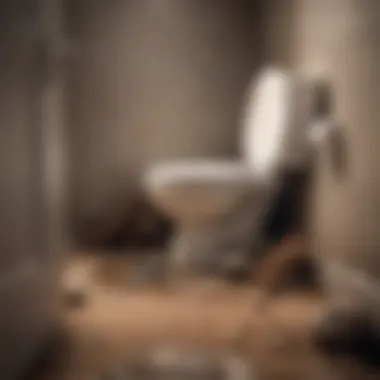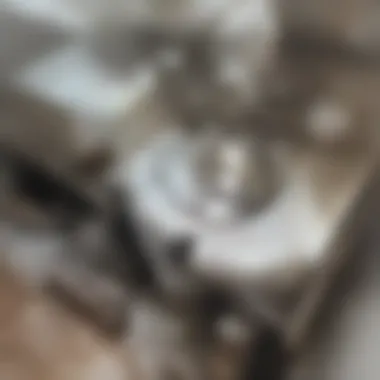Addressing Clogged Toilets: Insights and Solutions


Intro
Clogged toilets are a common issue faced by homeowners. Understanding the causes, solutions, and preventive measures is essential for maintaining a smooth plumbing system. This discussion explores practical insights and various tools available, particularly those found at Home Depot, to address these clogs effectively. With proper knowledge, homeowners can tackle plumbing issues and avoid future problems, making toilet maintenance a manageable task.
Causes of Toilet Clogs
Several factors contribute to toilet blockages. It is crucial to identify these causes for effective resolution.
- Excessive Toilet Paper Usage: Using too much toilet paper can easily lead to blockages. Having an awareness of how much is appropriate is key.
- Non-flushable Items: Items such as wipes, feminine hygiene products, and paper towels should never be flushed. Their presence in the toilet can cause significant clogs.
- Flushing Objects: Small toys or other household items can accidentally be flushed, resulting in blockages. Regular checks can prevent this.
Tools and Products for Clearing Clogs
Equipping yourself with the right tools can simplify the process of clearing toilet clogs. Some essential items include:
- Plunger: A simple but effective tool. Select a quality plunger for better results. Look for one designed specifically for toilets.
- Toilet Auger: This tool can reach deeper clogs that a plunger cannot. Understanding how to use it properly is vital.
- Enzyme Cleaners: These products can break down organic material within the drain. However, they are slow-acting and may not provide immediate results.
- Wet/Dry Vacuum: For more significant blockages, a vacuum can be a useful option.
Preventive Measures
Taking steps to prevent clogs can save time and money. Here are some effective methods:
- Educate Household Members: Ensure everyone understands what can and cannot be flushed.
- Regular Maintenance: Inspect your toilet and plumbing regularly to catch issues early.
- Install Dual Flush Toilet: These toilets conserve water and can help manage waste better.
When to Consult Professionals
Sometimes, despite best efforts, blockages can persist. Recognizing when to call in a professional is essential. Signs that indicate a need for expert help include:
- Frequent Clogs: If clogs happen often, it might be a sign of a larger issue in the plumbing system.
- Backflow Issues: If wastewater is backing up, this requires immediate professional attention.
- Poor Drainage: Slow drainage may signify a blockage within the pipes, necessitating expert evaluation.
"Understanding the plumbing system in your home empowers you to address issues efficiently and timely."
Finale
Addressing clogged toilets requires a blend of understanding, preventive efforts, and the right tools. Homeowners can manage this common issue effectively by using the insights provided. Knowing when to consult professionals can further ease the burden. Armed with knowledge and resources from Home Depot, individuals can maintain their plumbing with confidence.
Intro to Clogged Toilets
Clogged toilets represent a significant issue in home maintenance. They can disrupt daily routines and lead to more substantial plumbing problems if not addressed promptly. Understanding clogged toilets helps homeowners acknowledge the importance of preventive measures and recognize the signs of trouble before they escalate.
Understanding the Issue
Clogs can occur for various reasons, from improper items being flushed to the natural build-up of waste. Each scenario presents specific challenges. Recognizing how and why toilets become clogged allows homeowners to act swiftly and efficiently. Acknowledging the problem is often the critical first step. The sooner one understands the mechanics behind toilet blockages, the quicker they can implement solutions.
For many, the toilet is a basic necessity, yet its functionality is taken for granted until there is a problem. This makes it essential to grasp the impact of clogs. Issues like these can stem from household habits, such as what is disposed of in the toilet. Understanding these behaviors can help in modifying them to prevent future issues.
Impact on Daily Life
The effects of a clogged toilet extend far beyond inconvenience. Such situations can cause significant disruptions. Consider the morning rush: a clogged toilet can delay family routines, leaving little room for prompt resolutions. In homes with multiple occupants, this impact is amplified, often leading to frustration.
Moreover, clogs can also pose a health risk. If toilets overflow, it may expose residents to unsanitary conditions. This can escalate stress for families, particularly in times of high demand, such as gatherings or busy weekdays.
"Recognizing the early signs of a clogged toilet can save time and reduce stress during crucial moments."
Beyond immediate inconveniences, recurrent clogs can also lead to other plumbing issues, leading to costly repairs. By learning the intricacies of toilet function and maintenance, homeowners can better safeguard their living environment. An informed approach not only eases the daily burdens but also instills confidence in handling plumbing challenges.
Common Causes of Clogs
Understanding the common causes of clogged toilets is essential for effective home maintenance. Identifying these causes allows homeowners to take proactive measures to prevent blockages. Knowing the reasons behind clogs can save time, reduce frustration, and minimize repair costs. Each factor contributes distinctly to the problem, offering valuable insights into maintaining optimal toilet performance.


Inappropriate Items Flushed
One of the leading causes of toilet clogs involves flushing inappropriate items. Many homeowners may not realize that certain materials should never enter the plumbing system. Common culprits include:
- Feminine hygiene products: These can expand and cause significant blockages.
- Wipes: Even those labeled "flushable" often do not disintegrate as intended.
- Paper towels: Unlike toilet paper, these are thicker and can easily cause clogs.
- Food waste: Although it may seem trivial, small bits can aggregate over time.
Being aware of what can and cannot be flushed is crucial. Many clogs can be avoided with simple knowledge about the proper use of toilets.
Build-up of Waste and Paper
Over time, the combination of organic waste and toilet paper can create a dense build-up within the plumbing. This accumulation may start slow, but it can lead to severe blockages if not addressed. Key points to consider include:
- Frequency of Cleaning: Regular maintenance is important to clear any build-up before it becomes problematic. Utilization of cleaning agents can assist in breaking down waste.
- Volume of Paper Used: Excessive use of toilet paper in a single flush can quickly lead to clogs. Adhering to a moderate amount during use is advisable.
- Type of Toilet Paper: Thicker, plush types may contribute more to clogs than thinner options. It may be worth considering alternatives based on observed performance.
Poor Toilet Design
Design flaws in toilet models can also lead to clogs. Some toilets may be engineered in ways that hinder effective drainage. Factors to observe include:
- Flush Power: Toilets with insufficient flushing power are more likely to experience clogs. Those that utilize less water may not effectively clear waste.
- Bend Angle in Plumbing: Sharp angles or restrictive plumbing can obstruct waste flow. Understanding your home’s plumbing design can guide replacement or maintenance decisions.
- Small Trap Size: Toilets with smaller traps may struggle with waste passage, leading to frequent blockages.
Basic Tools for Unclogging
When confronted with a clogged toilet, having the right tools is crucial. Efficient unclogging not only alleviates immediate distress but also prevents further plumbing issues down the line. This section discusses the primary tools essential for unclogging toilets: plungers, toilet augers, and wet/dry vacuums. Each tool serves a unique purpose and understanding their functionalities can lead to better maintenance practices and effective problem resolution.
Plungers
Plungers are a common and effective tool for unclogging toilets. They work by using suction and pressure to dislodge blockages. There are different types of plungers, but the flange plunger is particularly effective for toilets due to its design. The flange creates a seal in the toilet bowl, maximizing suction and helping to push the clog out.
To use a plunger effectively, ensure that the toilet bowl has enough water to cover the rubber part of the plunger. This enhances the vacuum effect. Positioning the plunger correctly and applying firm strokes can often clear minor clogs in a matter of minutes. Frequent use can lead to a cleaner and better-maintained toilet as regular plunging helps dislodge potential build-ups.
Toilet Augers
Toilet augers take unclogging to another level, especially for persistent blockages. Unlike plungers, which rely on suction, augers use a flexible metal coil to break up or retrieve clogs located deeper within the toilet's trap. Their long reach can tackle stubborn clogs that are not accessible with simpler tools.
Using a toilet auger requires some care. Insert the auger into the toilet bowl until you feel resistance. Rotate the handle while pushing the auger further in. This will allow the coil to navigate through bends and curves, making it possible to break up tough clogs or pull out lodged items. A toilet auger is an important tool for homeowners who often encounter deeper plumbing issues.
Wet/Dry Vacuums
Wet/dry vacuums provide another effective method for dealing with clogged toilets, especially when the clog is severe. These powerful vacuums can siphon out the water from the toilet bowl, making it easier to access the blockage. Once the water is removed, other tools can be effectively employed.
To use a wet/dry vacuum, first remove the excess water from the toilet bowl. It may be necessary to also adapt the vacuum's nozzle to fit snugly in the toilet's opening. This direct connection increases suction and can pull out obstructions that are otherwise inaccessible.
Key Insight: While wet/dry vacuums are potent, they require careful operation to avoid spills and ensure proper use. Always remember to follow safety guidelines and manufacturer's instructions.
Understanding these tools—plungers, toilet augers, and wet/dry vacuums—enhances home maintenance strategies. With a well-equipped toolbox, homeowners can effectively manage clogged toilets and minimize the risk of extensive plumbing problems.
Home Depot: Your Clogged Toilet Solution
Home Depot plays a crucial role in providing effective solutions for clogged toilets. Given the frequency of this plumbing issue, homeowners often seek reliable avenues to address the problem. Home Depot stands out because of its wide range of products and expert support services.
The store offers practical tools, cleaning products, and maintenance kits tailored specifically for toilet issues, making it easier for customers to find comprehensive solutions under one roof. This convenience can save time and reduce frustration when addressing plumbing concerns at home.
Available Products
Drain Cleaners
Drain cleaners are chemical solutions designed to dissolve clogs and clear blocked pipes. They contribute significantly to plumbing maintenance by helping to restore flow without the need for mechanical tools. A key characteristic of drain cleaners is their active ingredients, which can effectively break down organic matter, hair, and soap scum. Drain cleaners are a popular choice because they offer immediate results, often delivering instant relief for common clogs.


However, it is essential to note that some drain cleaners can be harsh on plumbing systems, especially older pipes, leading to potential damage. They must be used according to instructions to avoid negative outcomes.
Plumbing Equipment
Plumbing equipment encompasses a variety of tools and devices designed for clearing clogs physically. This includes plungers, augers, and snakes. The critical feature of plumbing equipment is its ability to provide direct intervention to the clog itself. Homeowners often find it beneficial, as these tools allow personal interaction with the toilet system, ensuring a hands-on approach to plumbing challenges.
The advantage of using plumbing equipment is the potential for effective, long-lasting solutions. However, it requires certain skills and a clear understanding of how to use each tool properly, or else it can lead to further complications in the plumbing system.
Maintenance Kits
Maintenance kits are comprehensive packages that include several products designed for regular plumbing upkeep. They typically contain essential tools such as plungers, cleaners, and drain brushes. The vital aspect of maintenance kits is that they provide homeowners with everything necessary for complete care of their plumbing systems.
These kits are advantageous because they help prevent clogs by promoting routine maintenance. However, some kits might not contain all the tools one may need for severe problems, making it essential to assess the kit contents before purchase.
Guidance and Support
Expert Advice
Expert advice is invaluable when dealing with plumbing issues. Home Depot provides access to plumbing professionals who can offer guidance based on individual plumbing situations. The critical characteristic of expert advice is its personalized nature.
Homeowners benefit from tailored recommendations that can help them choose the right products and techniques for their specific situations. However, while expert advice can lead to better decision-making, it still requires homeowners to act on the advice given, which may require some level of confidence and understanding of plumbing systems.
Workshops and Tutorials
Workshops and tutorials are organized events where individuals can learn about plumbing maintenance and problem-solving techniques. These educational offerings play an important role in empowering homeowners. The key characteristic of such workshops is their hands-on experience, allowing participants to practice skills in real-time.
Workshops and tutorials are beneficial as they enhance knowledge and confidence in managing plumbing issues. However, they typically require commitment in terms of time and participation, which may not be feasible for all homeowners.
Step-by-Step Unclogging Process
In the context of clogged toilets, a systematic approach is essential. The step-by-step unclogging process not only aids in resolving the immediate issue but also equips homeowners with skills to handle future instances. Understanding this procedure provides clarity and minimizes frustration during an already challenging situation. The benefits of following these steps are numerous, including saving time, reducing the need for professional help, and ensuring proper toilet maintenance.
Initial Assessment
Before diving into the unclogging action, conducting an initial assessment is crucial. Assess the severity of the clog. Is the bowl overflowing? Is there a complete blockage? Observing these signs helps determine the necessary tools and methods for resolution. Additionally, think about what's causing the blockage. Items like excessive toilet paper or foreign objects can often lead to troublesome clogs. Taking a moment to evaluate the situation will save time and effort later.
Choosing the Right Tool
Having the appropriate tools is vital for effectively dealing with a clogged toilet. Each tool serves a distinct purpose and choosing the right one can make a significant difference in the unclogging process. Here are some common tools:
- Plunger: Best for initial attempts. It works by creating suction and pushing the clog free.
- Toilet Auger: Ideal for tougher clogs deeper within the toilet’s trap.
- Wet/Dry Vacuum: Can be used to remove unwanted water or debris.
Selecting the right tool ensures a higher success rate in resolving the clog.
Using a Plunger Effectively
To use a plunger effectively, it’s important to follow specific steps. First, ensure there is enough water in the toilet bowl to cover the plunger's cup. This creates a seal, necessary for effective suction. Place the plunger over the drain and push down gently to release trapped air. Then, plunge vigorously up and down. Keep the seal intact as you pull the plunger up, creating a strong suction to dislodge the clog. This technique typically removes mild to moderate clogs; if the toilet still does not drain, consider using a toilet auger.
Employing a Toilet Auger
If plunging doesn’t resolve the issue, a toilet auger can be your next step. This tool is specifically designed for reaching clogs further down the piping system. Insert the auger into the toilet bowl and push it down until resistance is felt. Rotate the handle to help break apart the blockage. Be gentle to avoid damaging the toilet. Once you feel the clog disintegrate, pull the auger back out slowly, ensuring that you remove any debris. After using the auger, flush the toilet to see if the blockage is resolved.
Final Checks and Cleanup
Once you have unclogged the toilet, it’s essential to conduct final checks. Flush the toilet multiple times to ensure proper drainage. If there are no issues, proceed to clean up the area. Use disinfectant and paper towels to clean any spills or accidents during the process. Proper cleanup not only maintains hygiene but also prevents further plumbing issues.
Remember to always wear gloves and take precautions when handling plumbing tools. It helps in maintaining safety and cleanliness.


Following these steps systematically will empower homeowners to address clogged toilets more effectively. Developing these skills alleviates stress and encourages confidence in dealing with minor plumbing challenges.
Prevention Strategies
Clogged toilets can cause considerable inconvenience and stress. This section discusses effective prevention strategies that can significantly reduce the frequency of clogs. Implementing these strategies not only improves toilet functionality but also saves time and money on potential repairs.
Educating Household Members
One of the most vital preventive measures is education. All household members should understand what can and cannot be flushed down the toilet. It's essential to have clear communication about the risks associated with flushing inappropriate items. Common misconceptions exist about toilet usage. Items such as wipes, feminine hygiene products, and even excessive amounts of toilet paper can lead to serious clogs. Providing instruction can help prevent unnecessary plumbing issues.
Encouraging household members to pause and consider their actions can help establish good habits. Simple signage in the bathroom can serve as a constant reminder of proper toilet use.
Regular Maintenance Checks
Scheduled maintenance is paramount for keeping toilets in optimal condition. Regular checks can lead to early detection of potential issues. Homeowners should inspect their toilets for any noticeable problems. Look for leaks, fluctuating water levels, or strange sounds during flushing. These signs could indicate underlying concerns that may result in a clog.
Additionally, flushing the toilet and monitoring the flow regularly is a good practice. If the toilet does not clear quickly and efficiently, it may indicate a blockage forming within the pipes. Keeping up with these checks can help catch issues before they escalate.
Proper Use of Toilets
Understanding the correct way to use a toilet can prevent many problems. Homeowners should encourage all family members to use toilets appropriately. This includes only using toilets for human waste and toilet paper. Children, in particular, may need guidance on these best practices.
Using the toilet properly also requires awareness of flushing habits. Flushing once for liquid waste can be enough. Multiple flushes can lead to exhaustion of the system and increase the chances of clogs over time.
Regular reminders about toilet etiquette can foster a culture of care and responsibility among household members, reducing the likelihood of plumbing troubles.
When to Call a Professional
The intricacies of plumbing can often overwhelm homeowners. When confronted with a clogged toilet that resists all remedial efforts, the question arises: should I call a professional? This section aims to elucidate the indicators that suggest the need for expert help, as well as the advantages of consulting plumbing services.
Signs of a Serious Problem
It is crucial to recognize signs indicating that a blockage is beyond typical fixes. Start by assessing the persistence of the issue. If a toilet routinely clogs even after multiple attempts at clearing it, or if multiple toilets in the home are affected, it may signify a larger plumbing problem. Other indicators can include:
- Foul Odors: Unpleasant smells emanating from the toilet or drains might indicate trapped waste or a failed sewer line.
- Slow Draining: Water that takes an unusually long time to drain could suggest an underlying obstruction.
- Gurgling Noises: Sounds from the toilet or nearby drains that happen when flushing can point to draining issues further along the line.
These symptoms often hint at deeper issues like tree root intrusion or a collapsed sewer line, conditions that require professional evaluation and repair.
Consulting Plumbing Services
Engaging a qualified plumber brings several benefits. First, these professionals have specialized tools like cameras and sensors to diagnose plumbing issues more effectively than standard DIY methods. Their experience can lead to a quicker resolution, ultimately saving money on extensive repairs later on.
When deciding on a plumbing service, consider the following aspects:
- Certifications and Licenses: Ensure the plumber carries the necessary credentials to operate in your area.
- Reviews and References: Check online reviews or ask for referrals to gauge their service's reliability and quality.
- Cost Estimates: Ask for transparent pricing to avoid unexpected charges.
"Many homeowners underestimate the complexity of plumbing issues. A thorough understanding of when to reach out for professional help can save considerable time and costs in the long run."
In summary, recognizing the signs of a serious plumbing issue is paramount. When persistent problems occur, or when facing symptoms that suggest more than just a simple clog, reaching out to plumbing services can provide clarity and solutions that homeowners might struggle to achieve alone.
Epilogue
Addressing clogged toilets is an issue that many homeowners face. It not only impacts day-to-day life but can also lead to larger plumbing problems if not managed properly. This article has provided insights into the causes of toilet clogs, tools for addressing the problem, and strategies for prevention.
Recap of Essential Information
In this article, we explored several key topics related to clogged toilets:
- Understanding the Issue: Recognizing that clogs occur due to various reasons, including inappropriate items being flushed and natural build-up.
- Common Causes of Clogs: Identifying specific factors, such as waste accumulation and poor toilet design, that contribute to blockages.
- Basic Tools for Unclogging: Utilizing tools like plungers, toilet augers, and wet/dry vacuums can provide effective solutions.
- Home Depot as a Resource: Home Depot offers a range of products designed to tackle clogs and provides expert advice.
- Step-by-Step Unclogging Process: A systematic approach ensures that homeowners can clear clogs effectively.
- Prevention Strategies: Educating household members and performing regular maintenance checks can significantly reduce the likelihood of clogs.
- When to Call a Professional: Knowing the signs of serious plumbing issues can save time and avoid damage.
Final Thoughts on Maintenance
Maintenance is crucial in preventing clogged toilets. Simple measures, such as monitoring what is flushed and conducting regular checks, can help maintain plumbing health. As a homeowner, it is beneficial to develop a habit of inspecting plumbing systems to preemptively address potential issues before they escalate. Moreover, investing time in learning appropriate flushing habits can save considerable effort and cost in the long run. By being proactive about maintenance, one can ensure that their plumbing system remains in good working condition. This can lead to not only healthier home infrastructure but also a more comfortable living environment.















